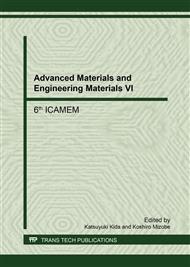p.413
p.418
p.423
p.428
p.433
p.441
p.446
p.451
p.456
Simulation on the Compression Molding Process of Biomass Material
Abstract:
ANSYS finite element analysis theory was employed to simulate the process of biomass compression molding. The analysis and calculation like element selection, material attribute setting, mesh generation, contact pair establishment, load and constrain applying and solver setting were finished. The results shows that: The biomass produced in this mold contains heterogeneous density where the density in one end is higher than the other end; There is still shear stress at the section of molding fuel, which cannot be removed after molding; moreover, along with the natural expansion of biomass material after compression, crack is likely to appear on the surface of biomass molding fuel. With respect to mold, it is obvious that, the stress of top of compression material to mold is the largest, which is caused by the concentrated stress on mold generated by joint action of friction between raw material and mold, larger extrusion force at top and deformation force of raw material resisting compression. Thus, the abrasion of this mold at this part is the largest.
Info:
Periodical:
Pages:
456-460
Citation:
Online since:
August 2017
Authors:
Keywords:
Price:
Сopyright:
© 2017 Trans Tech Publications Ltd. All Rights Reserved
Share:
Citation:


